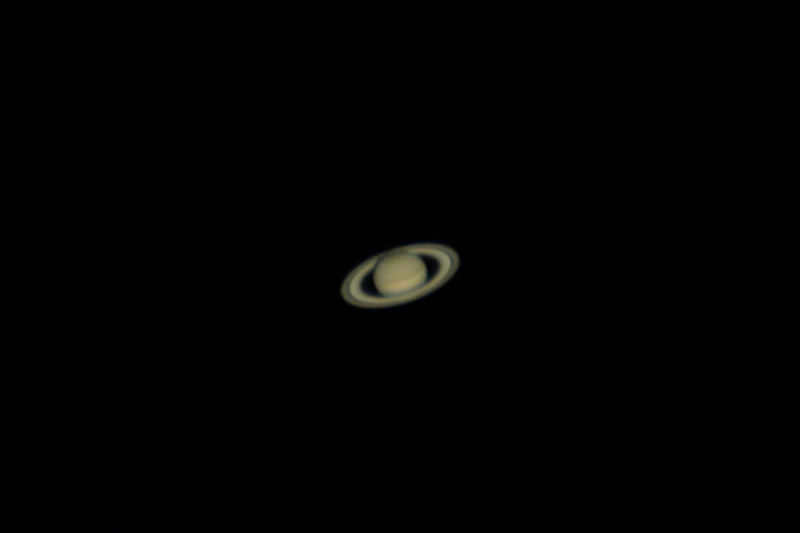Saturn, the 6th planet from the Sun, is the second-largest planet in our solar system. Similar to its counterpart, the gas giant Jupiter, Saturn is a massive sphere primarily composed of hydrogen and helium. While other planets also possess rings, none can compare to the breathtaking complexity and magnificence of Saturn’s rings. Furthermore, Saturn boasts an extensive collection of moons.
From the astonishing water jets emanating from Saturn’s moon Enceladus to the presence of methane lakes on the hazy moon Titan, the Saturn system provides an abundant source of scientific revelations and continues to harbor numerous enigmas.
Namesake
The most distant planet from Earth that was discovered by the naked human eye, Saturn has been known since ancient times. The planet is named after the Roman god of farming and prosperity, who was also the father of Jupiter.
Potential for Life
Saturn’s conditions are not suitable for life as we currently understand it. The temperatures, pressures, and substances that define this planet are likely too extreme and unpredictable for organisms to adapt to.
Although Saturn itself is an unlikely place for living organisms to flourish, the same cannot be said for some of its numerous moons. Satellites like Enceladus and Titan, which have internal oceans, could potentially harbor life.
Size and Distance
Saturn has a radius of 36,183.7 miles (58,232 kilometers), making it 9 times larger than Earth. If Earth were the size of a nickel, Saturn would be equivalent to the size of a volleyball.
Located at an average distance of 886 million miles (1.4 billion kilometers), Saturn is 9.5 astronomical units away from the Sun. An astronomical unit (AU) is the distance between the Sun and Earth. It takes sunlight approximately 80 minutes to travel from the Sun to Saturn at this distance.
Discover a 3D representation of Saturn, the magnificent planet adorned with rings. Credit: NASA Visualization Technology Applications and Development (VTAD) › Download Options
Orbit and Rotation
Saturn’s rotation period is one of the shortest in the solar system, with a day lasting only 10.7 hours. This is the amount of time it takes for Saturn to complete one full rotation or spin around its axis. In terms of its orbit around the Sun, which is equivalent to one year in Saturnian time, Saturn completes this journey in approximately 29.4 Earth years or 10,756 Earth days.
Similar to Earth, Saturn has a tilted axis. Its axis is tilted by 26.73 degrees with respect to its orbit around the Sun. This is very close to Earth’s tilt of 23.5 degrees. As a result of this tilt, Saturn also experiences seasons, just like our planet.
Moons
Saturn houses a wide variety of fascinating and exceptional celestial bodies. From the mist-covered terrain of Titan to the pockmarked surface of Phoebe, each of Saturn’s moons reveals another aspect of the narrative surrounding the Saturn system. Saturn possesses a total of 83 moons. Out of these, 63 moons have been verified and given names, while an additional 20 moons are currently awaiting official confirmation of their discovery and subsequent naming by the International Astronomical Union (IAU).
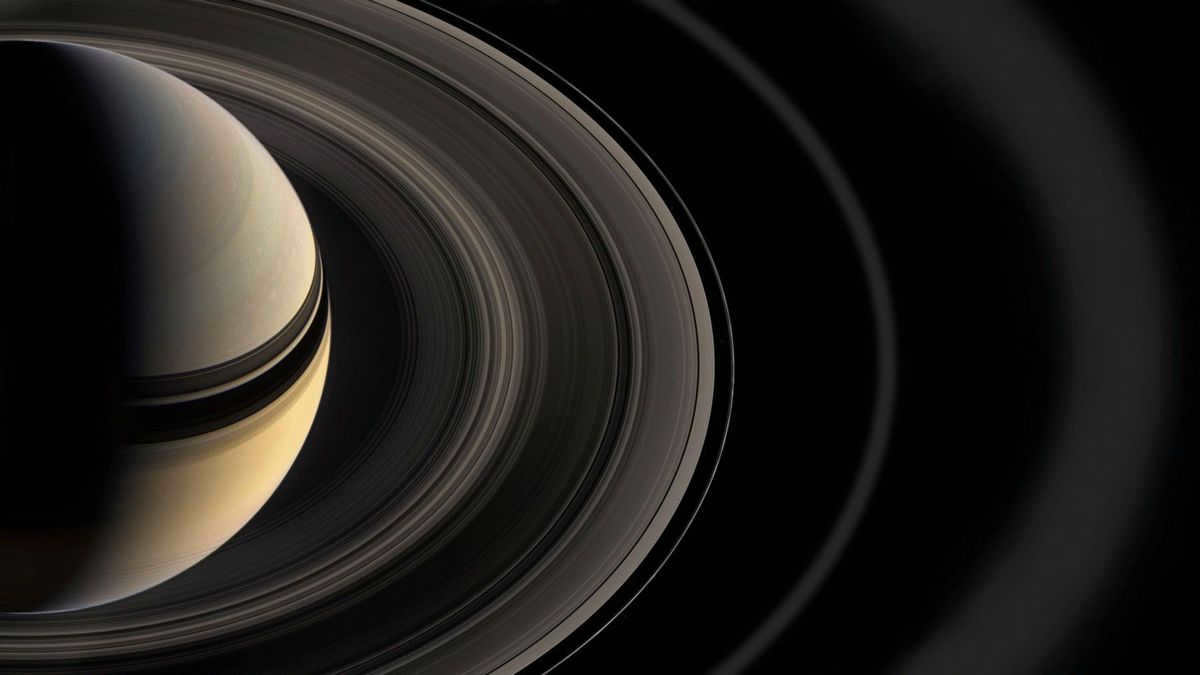
The Formation of Saturn’s Rings
Scientists believe that Saturn’s rings are composed of remnants of comets, asteroids, or moons that disintegrated before reaching the planet due to the tremendous gravitational pull exerted by Saturn. These rings consist of countless small fragments consisting of ice and rock, coated with various substances including dust. The size of the ring particles varies greatly, ranging from minuscule icy grains to massive chunks comparable to the size of a house. Some particles are even as large as mountains. When viewed from the cloud tops of Saturn, the rings appear predominantly white. Interestingly, each ring orbits the planet at a different velocity.
The ring system of Saturn stretches to a distance of 175,000 miles (282,000 kilometers) from the planet, but the height of the rings is typically around 30 feet (10 meters) in the main rings. The rings are named alphabetically in the order of their discovery, and they are relatively close to each other, except for the Cassini Division, which is a gap measuring 2,920 miles (4,700 kilometers) wide that separates Rings A and B. The main rings are A, B, and C, while Rings D, E, F, and G are fainter and were discovered more recently.
Starting from Saturn and moving outward, we have the D ring, C ring, B ring, Cassini Division, A ring, F ring, G ring, and finally, the E ring. Farther out, there is the very faint Phoebe ring in the orbit of Saturn’s moon Phoebe.
Saturn came into existence during the formation of the rest of the solar system approximately 4.5 billion years ago, when swirling gas and dust were pulled together by gravity to create this immense gas giant. Around 4 billion years ago, Saturn found its place in the outer reaches of the solar system as the sixth planet from the Sun. Similar to Jupiter, Saturn is predominantly composed of hydrogen and helium, the two primary elements also found in the Sun.
Structure
Similar to Jupiter, Saturn is primarily composed of hydrogen and helium. At the center of Saturn lies a compact core consisting of metals such as iron and nickel, which is surrounded by solidified rocky material and other compounds formed under immense pressure and heat. This core is enveloped by a layer of liquid metallic hydrogen, enclosed within a layer of liquid hydrogen – a configuration akin to Jupiter’s core, albeit on a smaller scale.
It may seem unimaginable, but Saturn is the sole planet within our solar system with an average density lower than that of water. This massive gas giant could hypothetically float in a bathtub, if such a colossal vessel existed.
Surface
Unlike terrestrial planets, Saturn does not possess a solid surface. Instead, it is composed primarily of swirling gases and liquids that extend far into its interior. Although there is no place for a spacecraft to land on Saturn, attempting to navigate through its atmosphere would prove equally treacherous. The immense pressures and temperatures deep within the planet would annihilate any spacecraft, causing it to be crushed, melted, and vaporized.
Environment
The atmosphere surrounding Saturn is characterized by the presence of clouds, which give the planet its distinct appearance. These clouds can be observed as faint stripes, jet streams, and storms. Saturn’s atmosphere is composed of various shades of yellow, brown, and gray.
The upper atmosphere of Saturn experiences incredibly powerful winds, with speeds reaching up to 1,600 feet per second (500 meters per second) in the equatorial region. This is significantly faster than the strongest hurricane-force winds on Earth, which only reach about 360 feet per second (110 meters per second). Additionally, the pressure in Saturn’s atmosphere is so intense that it compresses gas into a liquid form, similar to the pressure experienced when diving deep underwater.
Saturn’s northern pole is home to a fascinating atmospheric phenomenon – a jet stream that takes the shape of a hexagon. This unique pattern was initially discovered in photographs taken by the Voyager I spacecraft and has since been studied in greater detail by the Cassini spacecraft. Stretching across approximately 20,000 miles (30,000 kilometers), this hexagon-shaped jet stream is characterized by powerful winds reaching speeds of 200 miles per hour (322 kilometers per hour), with a colossal, rotating storm at its core. This extraordinary weather feature is unparalleled anywhere else within our solar system.
While Jupiter’s magnetic field is larger than Saturn’s, Saturn still boasts a magnetic field that is 578 times stronger than Earth’s. The vast magnetosphere of Saturn encompasses not only the planet itself, but also its iconic rings and numerous satellites. Within this magnetic domain, the behavior of charged particles is primarily influenced by Saturn’s magnetic field rather than the solar wind.
Aurorae are created when charged particles follow magnetic field lines and enter a planet’s atmosphere. On our planet, these particles originate from the solar wind. However, the Cassini spacecraft revealed that some of Saturn’s aurorae are similar to those on Jupiter and are not significantly influenced by the solar wind. Instead, these aurorae are formed by a combination of particles emitted by Saturn’s moons and the rapid rotation of Saturn’s magnetic field. Nevertheless, the exact nature of these “non-solar-originating” aurorae remains a mystery.
Resources
Quick Facts
Aside from our home planet, Saturn stands out as one of the most recognizable celestial bodies in our solar system. With its massive and stunning rings, Saturn puts on a show that no other planet can rival.
Saturn
Saturn, the second largest planet in our solar system, is located sixth in distance from the Sun. As a gas giant, it is a staggering 95 times more massive than Earth. Notably, Saturn boasts the lowest density of all the planets, even lighter than water. This enigmatic planet captivates with its extraordinary appearance. Its mesmerizing rings make it a true anomaly in the cosmos, setting it apart from all other planets. Truly one of a kind.
What is the meaning of the name Saturn? The name Saturn is believed to have originated from the god Saturn, who was the ruler of the powerful titans in Greek mythology. The planet was named after the god because of its immense size and distinctive appearance.
Atmosphere
The atmosphere of Saturn is characterized by intense winds that reach speeds of up to 500 km/h, and occasionally even 1500 km/h. While this may seem like an unpleasant phenomenon, when observed from Earth through a telescope, these winds create a mesmerizing spectacle. On Saturn, there are massive cyclones that sweep across its surface, with the largest one being a prominent white oval. This particular cyclone, known as the Great White Oval, is a powerful anticyclone that emerges approximately once every 30 years. Its immense size spans around 17,000 kilometers.
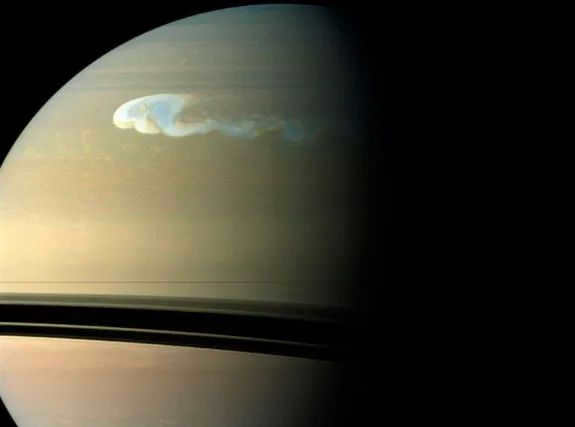
Saturn’s atmosphere is primarily composed of hydrogen and helium, with a minor presence of nitrogen. The upper layers of the atmosphere contain clouds of ammonia.
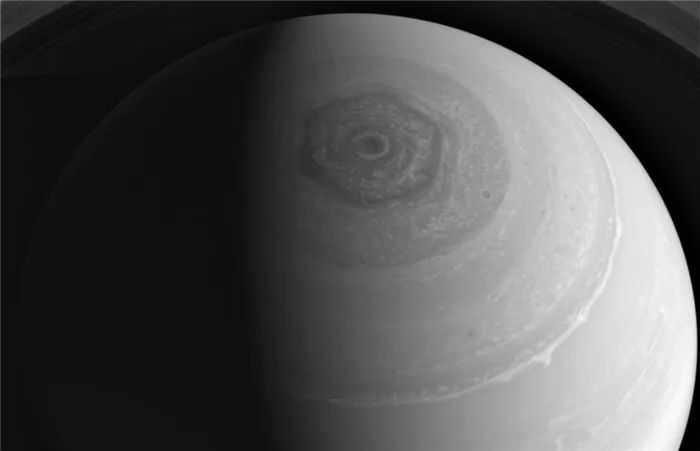
There exist patches and other structures. On Jupiter, for instance, several of them are of considerable size, measuring approximately 11,000 kilometers. This is truly remarkable. Additionally, there are smaller brown spots that span only around 3,000 kilometers in diameter and 10,000 kilometers in size.
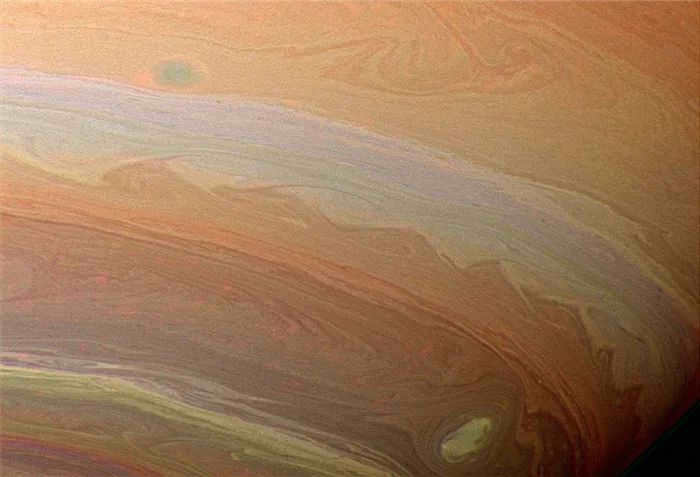
There are also regions that scientists speculate are created by variations in temperature. These regions are numerous, and the most intense winds are found in the center of the belt. The upper atmosphere is extremely frigid. The temperature range is -180°C to -150°C. This is exceedingly cold, yet if the planet is not undergoing warming and the Sun is situated too distantly, the atmospheric temperature will be considerably lower.
Saturn lacks a solid surface, with only visible cloud tops. The upper layer is composed of frozen ammonia, while the lower layer consists of ammonium. As we approach the planet, the hydrogen atmosphere becomes denser and warmer.
Internal composition
The internal structure of Saturn closely resembles that of Zeus. Scientists believe that there is a massive silicate core located at the planet’s center. This core extends about 30,000 kilometers deep and maintains a temperature of approximately 10 °C, with an atmospheric pressure of roughly 3 million. Within the core, the pressure and temperature increase even further. This core serves as the source of the planet’s internal heat, which surpasses the amount of heat received from the Sun.
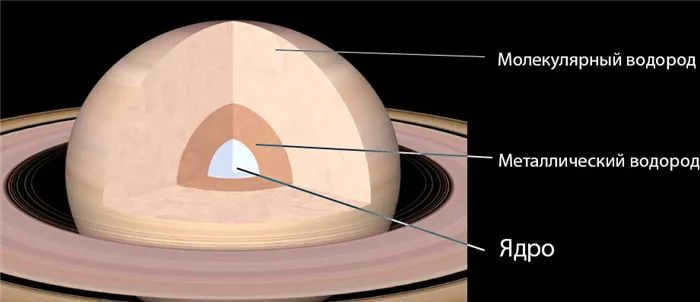
In the metallic state, hydrogen surrounds the core, with a layer of liquid molecular hydrogen above it that transitions to gas near the atmosphere’s surface. The magnetic field of the planet exhibits distinct characteristics that align with its axis of rotation. While Saturn’s magnetosphere is symmetrical, the radial poles possess a typical shape and gap.
Rings
The rings were initially discovered by the renowned Galileo Galilei in 1610. Subsequently, utilizing a more advanced telescope, the Dutch astronomer Huygens proposed that Saturn possessed two rings, one slender and one level. In reality, there exist numerous additional rings composed of various ice and rocks of diverse dimensions, which effortlessly clear anything obstructing their trajectory. These rings are immense, with the largest one being 200 times the size of the planet itself. Essentially, they consist of remnants from damaged comets, satellites, and other extraterrestrial debris.
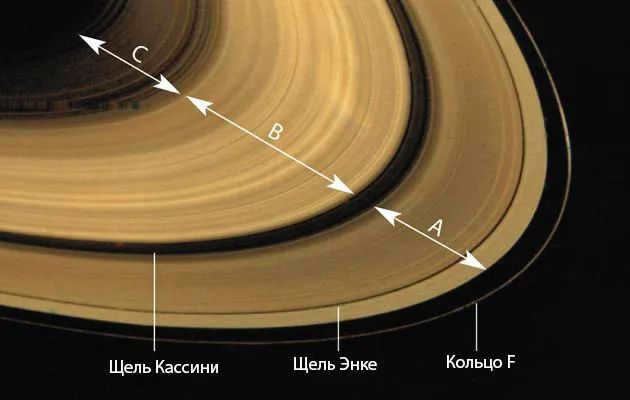
It is worth noting that the rings of Saturn are also given specific names, which are arranged in alphabetical order. For instance, there is the A ring, followed by the B ring, then the C ring, and so on.
Within these rings, there are various interesting features such as Mima, Egerados, Tephia, and Dioni. These features are composed mainly of water ice and are believed to have a rocky core, ice mantle, and crust. The smallest feature, Mima, has a diameter of Z96 km and a mass of 0.4 x1020 kg. It has an oval shape and is located approximately 185.5Z9 km away from the planet, completing an orbit around it in 0.9 days.
Brief description
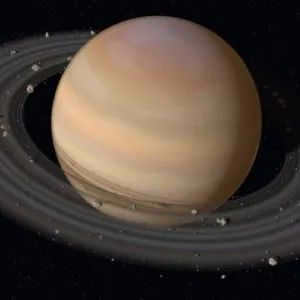
The ring systems of Saturn are a mesmerizing spectacle. Composed of fragments of ice, rock, dust, and remnants of former satellites destroyed by the gravitational pull, they are situated high above the planet’s equator, spanning a distance of about 6,000-120,000 km/s. Despite their expansive reach, the rings themselves are remarkably thin, with each ring measuring approximately 1 km in thickness. The entire system is comprised of four distinct rings, three of which are denoted by Latin letters. The central ring, known as B, shines the brightest and boasts the widest expanse. It is separated from the A ring by a gap known as the Cassini gap. Within this gap lies the thinnest and most transparent ring. Our knowledge of the rings surrounding the four gas giant planets is limited, with the exception of Saturn, where the rings are barely perceptible.
Currently, there are 62 confirmed satellites orbiting Saturn. Among the oldest of these are Titan, Egerados, Mimas, Tefia, Dione, Iapetus, and Rhea. The largest of these satellites, Titan, bears a striking resemblance to our own planet Earth. It boasts a multi-layered atmosphere and even has a liquid surface, a fact that has been scientifically established. Meanwhile, the smaller objects in Saturn’s orbit are thought to be remnants of asteroids, some of which may be less than one kilometer in diameter.
Planet formation
There are two theories regarding the genesis of Saturn.
The initial proposition, known as the “compression” hypothesis, suggests that the Sun and the planets underwent a similar formation process. In the early stages of the solar system, a disk composed of gas and dust existed, wherein distinct regions gradually emerged, exhibiting higher density and compactness compared to the surrounding material. These concentrations ultimately gave rise to the Sun and the planets as we recognize them today. This phenomenon elucidates the resemblances in the composition of Saturn and the Sun, as well as their relatively low densities.
Per the second “magnification” theory, Saturn’s formation took place in two distinct stages. The initial stage involved the creation of dense entities within a disk composed of gaseous dust, similar to a planet resembling Earth. It was during this period that a portion of the gas within the Job and Saturn regions dissipated into the vastness of space. This phenomenon accounts for the slight disparity in composition between these planets and the Sun. Subsequently, in the second stage, larger entities began to accumulate gas from the surrounding celestial clouds.
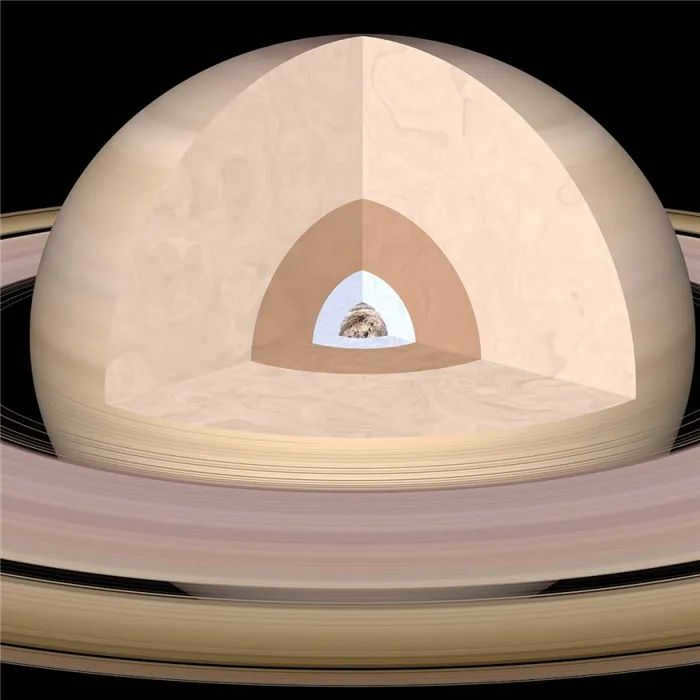
The core of Saturn is enveloped by a metallic layer composed of hydrogen. While in a liquid state, this hydrogen exhibits metallic properties. Due to its high electrical conductivity, the circulation of currents within it generates a powerful magnetic field. Situated approximately 30,000 kilometers beneath the surface, the pressure in this region reaches 300 GPa. Above this level lies a layer of liquid molecular hydrogen that gradually transitions into a gas upon contact with the atmosphere.
Saturn possesses remarkable dimensions: its equatorial diameter measures 120,536 kilometers, while its polar diameter spans 108,728 kilometers. Its total surface area encompasses 4.27×10^10 square kilometers, and its volume amounts to 8.27×10^14 cubic kilometers.
Temperature
Ammonia is the main component of atmospheric clouds, which are located about 100 kilometers below the top of the troposphere. In this region, the temperature can drop as low as -250°C. Moving further down, the clouds are made up of ammonium hydrogen sulfide, and the temperature here can vary, sometimes reaching -70 degrees Celsius.
Deep clouds, which are found 130 kilometers below the tropics, consist of water and have temperatures above 0 degrees Celsius.
The process of cloud formation follows a certain pattern. The lower the troposphere, the higher the temperature and the greater the amount of hydrogen gas present.
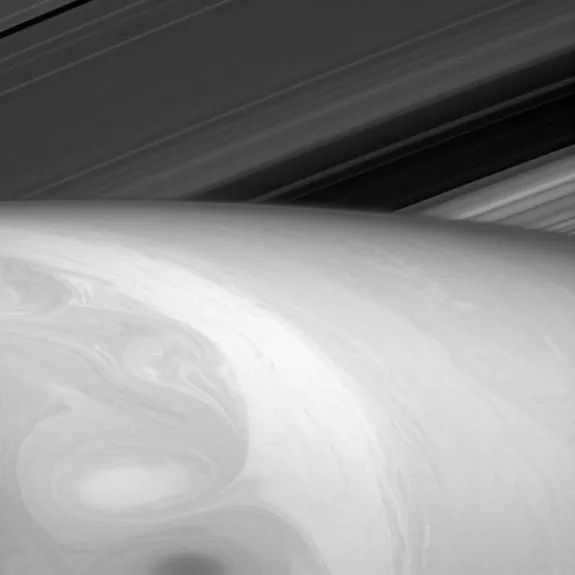
Hexagon
An extraordinary occurrence that scientists have observed in the atmosphere of Saturn is a heavily fortified hexagonal cloud. This phenomenon entails a cloud shaped like a hexagon, within which a hurricane is swirling. The hexagon measures 25,000 kilometers in diameter, which is four times larger than the diameter of Earth.
The rotational speed of the hexagon matches that of the planet. Inside, there exists a distinctive hurricane featuring a massive vortex. It completes one full rotation on its axis in 639 minutes.
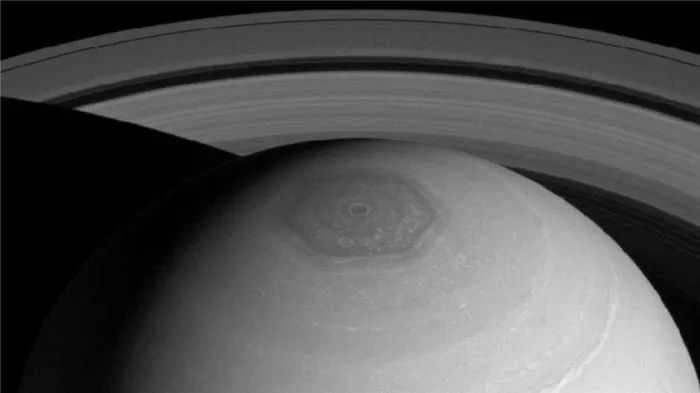
The Composition of Saturn
Similar to the other immense planets within our solar system, Saturn is primarily comprised of gas, specifically hydrogen. Consequently, it is illogical to assert that Saturn possesses a distinct surface.
Essentially, the only substances present on the planet are infinite gases, characterized by fluctuating pressures and temperatures. In essence, any material that holds significance on a planet is disintegrated and transformed into an array of gaseous elements.
From the perspective of an Earth inhabitant, other planets may appear to possess a solid surface. Even when observing a planet from a distance, it may seem comparable to our own. However, anything that appears to be a planet is, in reality, a gaseous sphere with constantly changing pressures and temperatures.
It is worth mentioning that the surface of Saturn experiences 91% of the gravitational force. Consequently, if an object weighs 100 kg on Saturn, it would weigh only 91 kg on Earth.
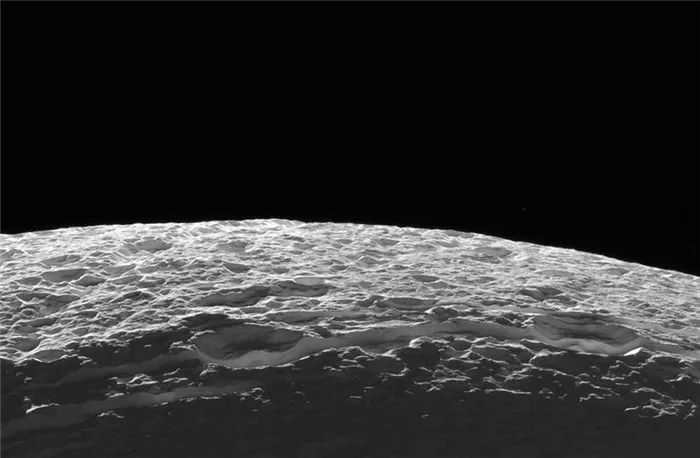
The rings of Saturn are categorized into seven groups, which are designated by the letters of the English alphabet in the sequence of their formation (D, C, B, A, F, G, and E). The F ring is held in place by two of Saturn’s moons, Prometheus and Pandora, known as the shepherd moons.
Saturn shares a similar structure with Jupiter and is composed of three distinct layers. The first layer is comprised of a solid rocky core, which is estimated to be 10 to 20 times denser than the Earth. This core is surrounded by a layer of liquid metallic hydrogen, with the core believed to be “embedded” within it. The outermost layer is made up of molecular hydrogen (H2). The primary difference between the structure of Saturn and Jupiter lies in the thickness of these two outer layers. Jupiter’s molecular hydrogen layer measures 46,000 km in thickness, while Saturn’s measures 14,500 km and 18,500 km respectively.
Similar to Zeus, Saturn emits approximately 2.5 times more radiation than it receives from the Sun. This phenomenon is attributed to the Kelvin-Helmholtz mechanism, which is caused by the gravitational compression of the planet and its immense mass, resulting in the release of energy. However, unlike Jupiter, the total amount of energy transferred cannot be accounted for solely by this process. Instead, scientists propose that the planet generates additional heat through friction with solar elements.
An intriguing characteristic of Saturn is its status as the most dense planet in our solar system. Despite possessing a solid core, the planet’s large outer layer of gas elevates its average density to a mere 687 kg/m3. Consequently, Saturn’s density is lower than that of water, allowing it to effortlessly float in a stream when reduced to the size of a matchbox.
The path and spin of Saturn
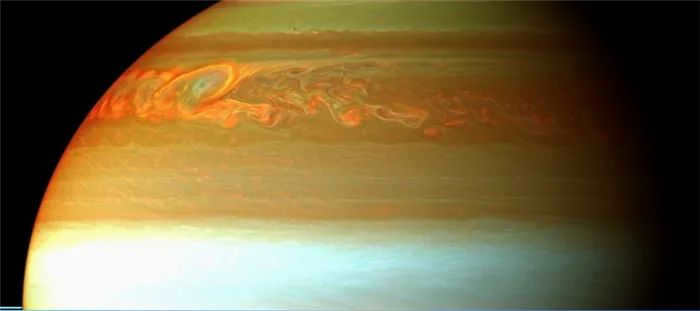
Saturn’s mean distance from the Sun is 1.43 x 109 km. This means that Saturn is positioned at a distance that is 9.5 times greater than the total distance from the Sun to Earth. Consequently, it takes approximately 20 minutes for sunlight to travel to Saturn. Furthermore, due to its extensive distance from the Sun, Saturn completes an orbit in 10,756 Earth days, which is equivalent to about 29.5 Earth years.
The orbital eccentricity of Saturn ranks as the third highest, following Hermes and Mars. This high eccentricity results in a significant difference between the planet’s perihelion (1.35 x 109 km) and aphelion (1.50 x 109 km), which amounts to approximately 1.54 x 108 km.
Saturn’s rotation is just as fascinating as Jupiter’s. With a speed of approximately 10 hours and 45 minutes, Saturn is the second fastest rotating planet in the solar system, only surpassed by Jupiter. These high rotation rates undoubtedly impact the planet’s shape, resulting in a slightly oblate spheroid shape, meaning it is slightly closer to the equator.
Another intriguing aspect of Saturn’s rotation is the varying speeds at different latitudes. This phenomenon is attributed to the fact that Saturn is primarily composed of gas rather than solid materials.
Formation of Rings
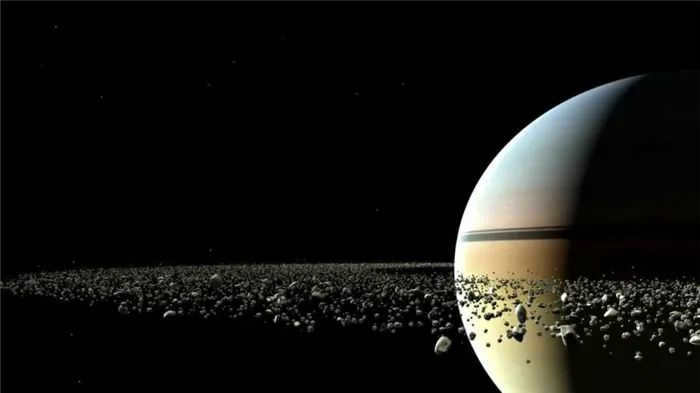
The primary characteristic of Saturn is its magnificent rings. How were these rings formed? There are several theories explaining their origin. Conventional theories suggest that the rings are nearly as ancient as the planet itself and have been in existence for at least four billion years. It is believed that during the early stages of Titan’s formation, a satellite located approximately 300 kilometers away disintegrated into debris. Another possibility is that two satellites collided with one another, resulting in the formation of the rings. Alternatively, it is plausible that a comet or asteroid of considerable size collided with the satellite and melted, subsequently settling into its orbit.
A different theory regarding the origin of the rings
Another proposition suggests that the satellites were not annihilated but rather the rings and the planets themselves were created by the solar nebula.
However, there lies a conundrum. The ice within the rings is remarkably uncontaminated. If the rings had formed on Saturn billions of years in the past, one would expect them to be entirely coated with debris from microvibrations. Yet, in the present day, they appear quite distinct, as if they emerged a mere 100 million years ago.
The rings adhere and collide with each other, perpetually renewing the material and potentially complicating the determination of their age. This remains one of the enigmas that have yet to be unraveled.
The equatorial circumference spans 378,675 km (compared to Earth’s 40,075 km), making it 9.4 times larger than that of Earth.
Of course, Saturn is not the biggest planet in our solar system. Taking the top spot is Jupiter, boasting a circumference of 449,197 km, which is 1.19 times larger than that of Saturn. However, when it comes to the largest object in our solar system, the title goes to the Sun, with a whopping circumference of 4,379,000 km, making it 11.56 times larger than Saturn. With these numbers in mind, you can truly appreciate the size of Saturn.
Saturn’s dimension
Saturn is the second biggest celestial body in terms of dimension in the solar system. It comes after Jupiter, the largest planet. It is a massive gas giant, differentiating itself from other celestial bodies due to its immense size and gas composition. To gain a basic understanding of its magnitude, it is important to ask, what is the dimension of Saturn, and also to make a comparative analysis with planet Earth.
Diameter
The equatorial diameter measures 120,536 kilometers, which is 9.5 times larger than that of Earth. However, due to its rapid rotation, Saturn is flattened at the poles and bulging at the waist.
Radius
The radius of Saturn is also worth noting. It measures 108,728 kilometers at the poles, which is 8.5 times larger than that of Earth. This huge difference in size is evident in comparative images, where Earth appears significantly compressed.
Size
The volume is equivalent to 827.13 trillion cubic kilometers, which is so immense that it could contain 763 Earth-sized planets. While these figures may pale in comparison to Jupiter, the largest planet in our solar system, they are still incredibly vast when compared to our own planet.
Saturn’s enormous size is also indicative of its vast surface area, which measures 42.7 billion square kilometers. This figure is 83.7 times larger than that of Earth, emphasizing the massive expanse of Saturn’s surface. If Saturn were composed of solid matter rather than gas, it would require years of study to fully comprehend. Despite its seemingly straightforward nature, this celestial body harbors countless enigmas.
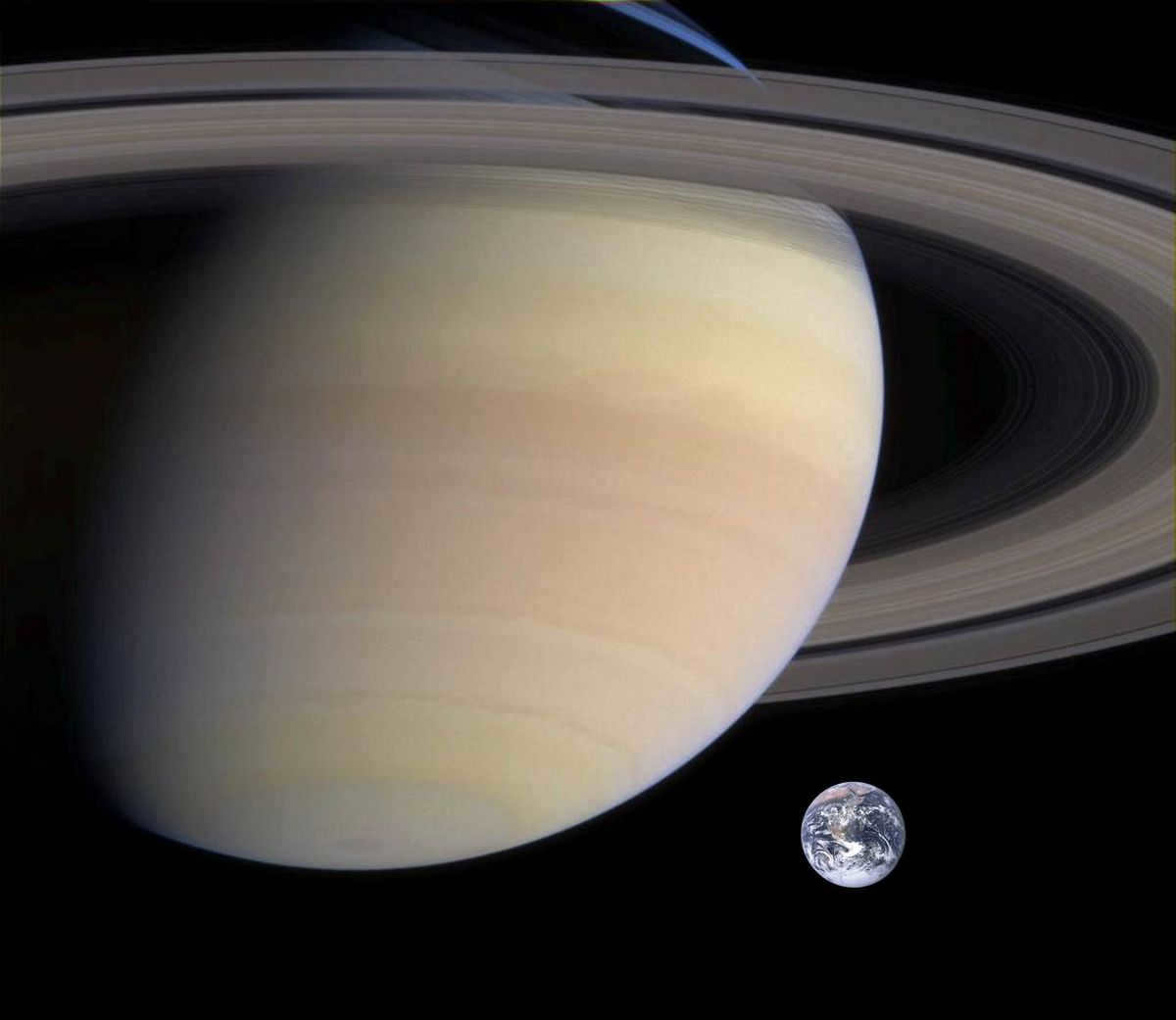
Comparison of Saturn and Earth (Photomontage)
Mass
Despite being made mostly of gas, Saturn is 95 times more massive than Earth. It weighs a staggering 568,360,000 trillion kilograms! However, when compared to Jupiter, these numbers seem small, accounting for only 30% of Jupiter’s mass. Jupiter is at least three times larger in mass.
Density
On one hand, Saturn has a mass 95 times that of Earth. On the other hand, how could it contain 763 of our planets? The answer is simple and lies in its density. Saturn is classified as a gas giant, meaning its matter is less dense compared to rocky surfaces. The density of Saturn is measured at 0.687 g/cc, which is even less dense than water. This explains why, if there were a large enough pool, Saturn could float on its surface.
Despite its impressive characteristics and enormous diameter, Saturn is by no means the largest celestial body. It not only follows in the footsteps of Jupiter, but there are also numerous objects beyond the solar system that are tens or even hundreds of times larger.
Orbital parameters
To gain a better understanding of Saturn’s magnitude, it is essential to acquaint ourselves with its various orbital characteristics:
- The average distance between Saturn and the Sun is approximately 1,430 million kilometers;
- The average speed at which Saturn orbits the Sun is 9.69 kilometers per second;
- It takes Saturn approximately 10,759 days to complete one orbit around the Sun (which is equivalent to 29.5 Earth years);
- The distance between Saturn and Earth is roughly 1195 million kilometers;
- The eccentricity of Saturn’s orbit is 0.056.
Despite the abundance of known parameters, there still exists a significant amount of debate among scientists. As a result, while the diameter of Saturn and certain other values are known, there are numerous unknown variables that continue to be the subject of ongoing research.
As a result, the celestial object has been relatively thoroughly examined, yet it continues to be actively explored by scientists to this day. You have the opportunity to acquaint yourself with the visuals on virtual maps or through the aid of a telescope.
Saturn – a planet’s overview, composition, atmospheric conditions, rings, photographs, and videos
Saturn, being the second largest planet in our solar system, is most commonly recognized for its prominent rings. This gas giant is regularly monitored by astronomers, and its distinct characteristics contribute to a greater comprehension of the universe’s structure. Presently, Saturn has been extensively researched, and anyone can access comprehensive information about it.
Dimensions, Weight, and Path
Saturn boasts remarkable proportions: it measures 120,536 km in diameter at the equator and 108,728 km in diameter at the poles. The total surface area spans 4.27 * 10'10 square kilometers, while the volume comprises 8.27 * 10'14 cubic kilometers.
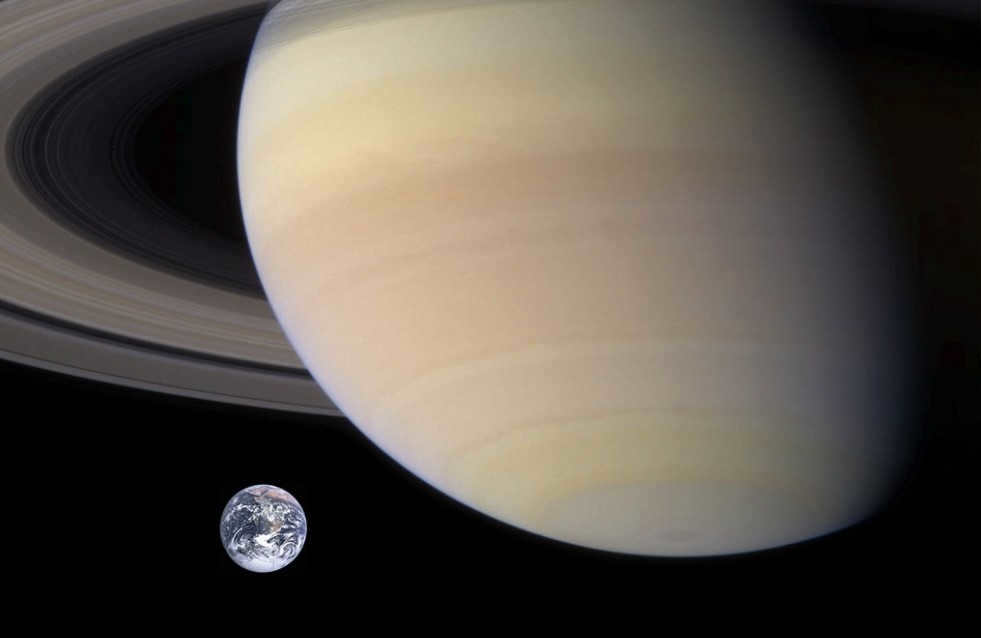
A visual comparison of the sizes between Saturn and Earth
Saturn is located at an average distance of 1.4 billion km from the Sun. Throughout its complete orbit around the star, the maximum distance it reaches is 1,513,783,000 km, while the minimum distance is -1,353,500,000 km. The rotational speed of Saturn is 9.69 km/s, although this can vary depending on its position in space. A year on Saturn lasts for 10,759 days, which is 29.5 times longer than a year on Earth.
Composition and Characteristics
Due to the fact that Saturn is classified as a gas giant, its surface exhibits a remarkably low density, measuring only 0.687 g/cc. The surface primarily consists of molecular hydrogen in a vapor state, which is saturated with helium.
Beneath this outer layer lies a dense accumulation of metallic hydrogen and helium in a liquid state. Additionally, there are traces of volatile substances within this mixture, although scientists have yet to determine their precise composition. At the core of Saturn lies a solid sphere with a radius of approximately 12,500 km, featuring an irregular surface. This core is intensely heated to temperatures reaching 11,700 degrees Celsius and may possess a composition that is comparable to Earth’s.
As a result of the elevated temperatures, the helium located in the core experiences heating and ascends gradually, making its way towards the upper layer. This phenomenon leads to a significant influx of energy onto the surface of the giant, surpassing the amount received from the Sun by two and a half times.
Composition of the Atmosphere and Temperature
The upper layer of the planet is predominantly composed of hydrogen, accounting for 96.3% of its volume. Helium makes up 3.25% of the atmosphere, while the remaining substances only contribute 0.45% to the overall composition. Notably, scientists have identified phosphine, ethane, acetylene, ammonia, methane, and propane among these trace substances.
Located above the surface is a cloud layer, which is further divided into upper and lower levels. The upper layer consists of ammonia crystals, while the lower layer is a mixture of water and ammonium hydrosulfide. These clouds are influenced by ultraviolet rays, which initiate the process of methane photolysis. As a result, hydrocarbon chemical reactions take place.
The atmosphere is composed of bands that progressively widen as they approach the equator. It can also be subdivided into two distinct layers. The upper layer exhibits a pressure range of 0.5 to 2 bar and temperatures ranging from -173 to -113 degrees Celsius. The lower layer, on the other hand, encompasses pressures of 10-20 bar and temperatures ranging from -3 to 57 degrees Celsius. Separating these layers is an intermediate layer comprised of ice clouds, where temperature and pressure transition smoothly.
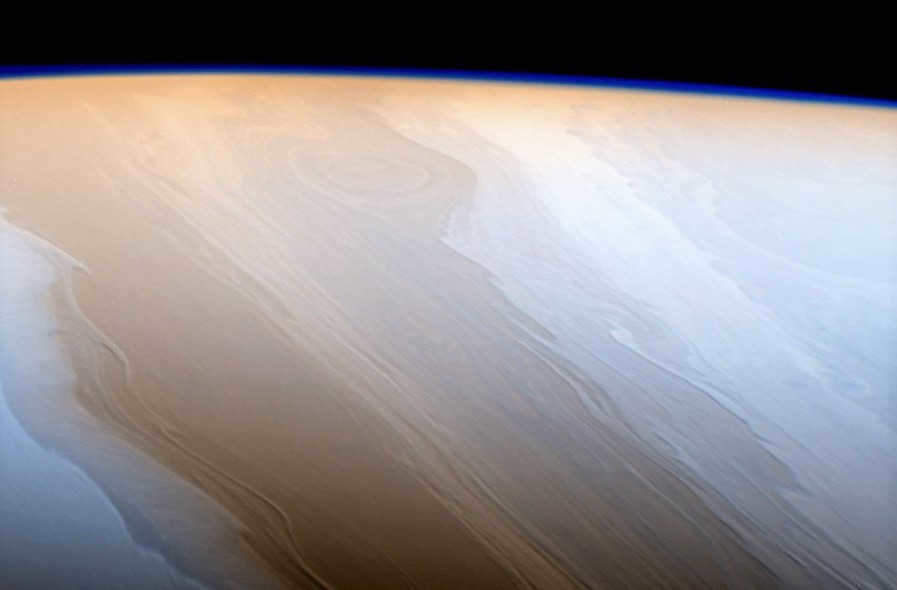
The atmosphere of Saturn
At times, oval-shaped spots that are whiter in color than the surrounding clouds form in Saturn’s atmosphere. This makes them easily distinguishable on the planet’s surface. The nature of these spots has yet to be explained by scientists, but observations indicate a pattern in their formation. For instance, when the gas giant’s northern hemisphere experiences the summer solstice, a Great White Spot appears in that area. There is a theory that links the formation of these white spots to electrostatic disturbances.
Winds blow across the planet’s surface, with speeds reaching up to 500 m/s. This is the second fastest wind speed in the solar system, after Neptune. In the northern region of Saturn, there are flows with a wave-like structure, while in the southern region, there are flows with a jet-like structure.
One of the most remarkable phenomena observed by the Hubble telescope was a massive hexagonal vortex swirling in the southern hemisphere of Saturn. This extraordinary wind stream had a remarkable radius of 6,900 kilometers and took a staggering 10 hours and 39 minutes to complete a full revolution.
Unveiling the Mysteries of Saturn’s Structure
Extensive studies conducted on Saturn have revealed that its internal structure closely resembles that of its celestial neighbor, Jupiter. Like Jupiter, Saturn is also composed of three distinct layers. At its very core lies a solid rocky core, estimated to be 10-20 times the mass of Earth. Surrounding the core is a layer of liquid metallic hydrogen, with a thickness of approximately 14,500 kilometers. Lastly, there is an outer layer, spanning a depth of 18,500 kilometers, consisting predominantly of molecular hydrogen.
Despite having a solid core, Saturn is primarily composed of gas and has a relatively low density.
Orbit and rotation
Throughout its journey around the Sun, the planet maintains an average distance of 1.43 billion kilometers. In contrast, the Earth is positioned 9.5 times closer to the star. Due to this significant separation, the planet completes a full revolution in 10,756 days.
Among the celestial bodies in the Solar System, the gas giant possesses the third highest eccentricity, surpassed only by Mars and Mercury. This measurement indicates the extent to which the orbit deviates from a circular shape. Specifically, it represents the difference between the maximum and minimum distances from the Sun. Saturn has an eccentricity of approximately 154,000,000,000 km, which is 400 times the distance between the Earth and the Moon.
The tilt of Saturn’s axis of rotation is 26.73 degrees, allowing for the changing of seasons on the planet. However, due to its great distance from the Sun, the variation in seasons is not as pronounced.
Compared to other planets, Saturn rotates on its axis quite rapidly, second only to Jupiter. A day on Saturn is only 10 hours and 45 minutes long. This high rotation speed causes the planet to have a slightly spherical shape, with a noticeable bulge at the equator.
The atmosphere and surface of Saturn are divided into visible latitudes, which also rotate at different speeds. This is due to the fact that the top layer of Saturn is composed of gases rather than solids.
Saturn’s magnificent rings
Saturn boasts the most remarkable rings among all the planets in our solar system. These rings consist mainly of frozen particles, space debris, and dust. This composition is what makes them so easily visible even from a considerable distance.
Currently, we are aware of seven distinct rings encircling this gas giant. To simplify matters, they have been designated with letters from the English alphabet in the order of their discovery: A, B, C, D, E, F, and G. When observing Saturn through a telescope from Earth’s surface, only rings A, B, and C are clearly discernible.
Research has revealed that these seven rings are made up of thousands of smaller rings that have fused together. However, there are gaps between these groups of rings. The largest gap exists between rings A and B, measuring a staggering 4700 km.
Although the total width of Saturn’s rings is approximately 66,000 km, their thickness is no more than a mere kilometer.
Rings Formation
The prevailing theory regarding the origin of Saturn’s rings posits that they materialized as a consequence of a celestial body’s disintegration. Roughly 4 billion years ago, a satellite composed primarily of ice orbited the gas giant. For unknown reasons, it ventured too close to Saturn’s surface, resulting in the gravitational forces shattering it into smaller fragments. These fragments, influenced by gravity, remained within the planet’s orbit and gradually coalesced into rings as Saturn rotated on its axis. The proximity of the satellite to the gas giant’s surface represents just one hypothesis for its demise, as it could have also collided with another celestial body.
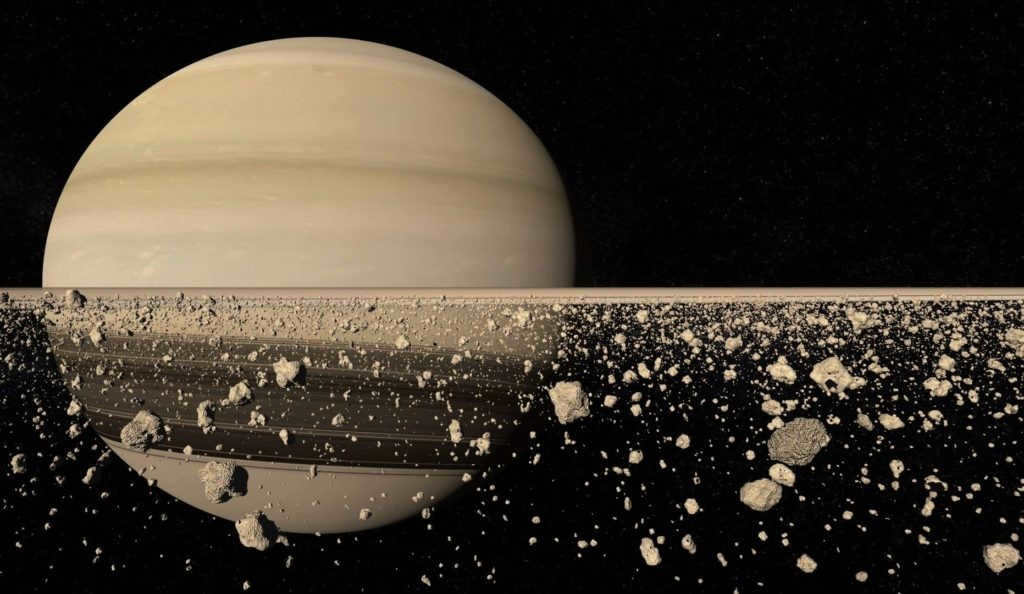
A detailed replica of the rings encircling Saturn
Moreover, there exists an alternative theory regarding the origin of these rings. It posits that they coalesced alongside Saturn during the formation of the solar nebula. However, if this were the case, the ice composing the rings would be coated in dust and other particles. Yet, the rings remain remarkably pristine. Proponents of this hypothesis argue that the absence of foreign debris is a result of the frequent collision of pebbles during their orbital motion.
Satellites orbiting the planet Saturn
There are 62 primary satellites revolving around Saturn, each with unique characteristics, while nine celestial bodies remain unnamed. More than half of these satellites have a radius of less than 5 km. However, there are also larger satellites in orbit around the gas giant, some of which can be as large as 5000 km.
The majority of these celestial bodies are named after the ancient Greek titans. Notably, there is a group of inner moons situated between the planet and its rings:
Saturn is a well-known planet, although many may not be familiar with its precise location and main characteristics. However, everyone is aware of Saturn’s main attraction – its magnificent rings. No other planet in the solar system possesses such a stunning piece of jewelry, resembling a sombrero.
You may have often wondered about the origins and composition of these peculiar formations. Now is the perfect time to uncover the answers to these inquiries and share them with your children.
Unraveling the Mystery of Saturn’s Rings
When observing Saturn through a telescope, its rings appear as a solid disc. This illusion is further reinforced by photographs taken by space probes that have ventured close to the planet. However, in reality, these rings cannot be solid.
Saturn’s rings consist of an immense number of small particles that orbit the planet within its equatorial plane. These particles range in size from micrometers to centimeters. Essentially, they are composed of dust and tiny stones, predominantly made up of ice. Additionally, there are larger stones, measuring several meters in diameter, and even blocks that stretch tens of meters across.
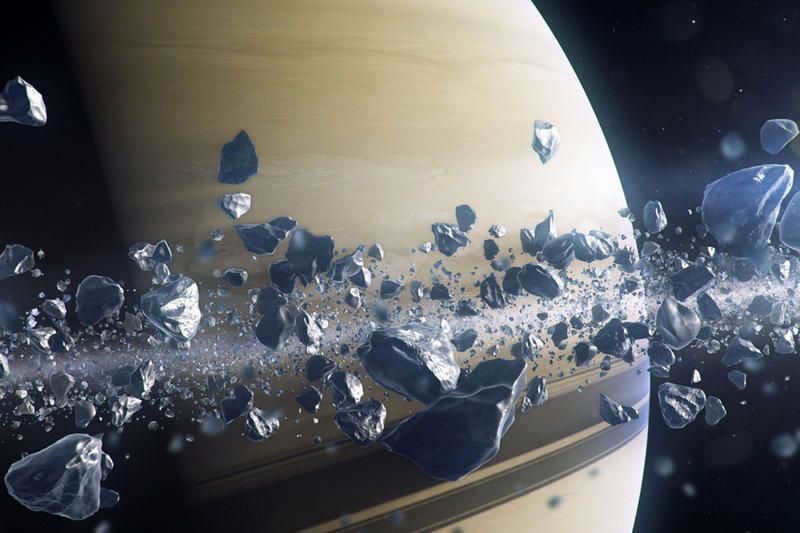

When observed from a close distance, the rings of Saturn would appear similar to the image above.
The ring system of Saturn consists of numerous individual rings with varying widths. These rings differ in thickness and composition, each having its own designated label. The outermost ring is known as the E ring.
The width of Saturn’s rings is incredibly vast. The outer edge of the E ring, located at a distance of 480,000 km from the planet’s center, has a width that spans 300,000 km alone. However, there are even wider rings present, although they are so sparse that they are nearly imperceptible. For instance, the Phebe ring, discovered in 2009, has a diameter of 13 million kilometers!
Simultaneously, the width of these formations is relatively larger in comparison to their thickness – ranging from several meters to a mile. This is the reason why they possess a level of transparency, allowing stars to peer through effortlessly.
Within certain regions, there exist vacant spaces of varying widths amidst the distinct rings. These spaces are labeled with names such as the Enke division, the Cassini gap, and other designations. In these spaces, the quantity of particles is significantly diminished.
The Unveiling of Saturn’s Rings
The initial observer of Saturn’s rings was Galileo Galilei in 1610, utilizing his 20x telescope. However, he was unable to comprehend their true nature due to the subpar image quality of his telescopes. Consequently, Galileo concluded that he had observed enigmatic “appendages” situated on the periphery of the planet, rendering it “triple”. He penned:
“The most elevated triple planet observed.”
In 1612, Galileo found himself perplexed as he no longer perceived anything at Saturn – during that time, the rings were oriented edge-on to the Earth, rendering them invisible. However, they eventually reappeared, once again visible to the naked eye.

Galileo Galilei, the scientist who made the discovery of Saturn’s rings, is widely known for his contributions to astronomy.
However, it was actually the Dutch astronomer Christiaan Huygens who was the first person to observe Saturn’s rings in detail. Using a telescope that he built himself with a magnification of 50x, Huygens was able to get a clear view of the rings. He documented his findings on March 5, 1656.
“The ring appears to be a thin, flat structure that does not touch any other part of Saturn and is inclined to the ecliptic.”
Although Huygens could not see the finer details of the rings with his telescope, he concluded that they were a single, solid and thin formation. This was a reasonable assumption given the limited magnification of his instrument. It is not surprising that Huygens reached this conclusion, considering that no one had ever seen such a remarkable phenomenon before.
Further research revealed more detailed information – Giovanni Cassini made a significant discovery in 1675 when he identified a gap in the ring, which was subsequently named after him as the Cassini gap. In 1859, James Maxwell proposed a theory that these structures could not be solid but rather composed of numerous small particles. This theory was later confirmed through spectrographic observations conducted ten years later.
Ever since their initial sighting by Galileo, the rings of Saturn have remained a perplexing phenomenon that has captivated the minds of countless scientists. For many centuries, their true nature eluded researchers, but thanks to the efforts of numerous scientists and the advancement of space probes, we now possess a considerable amount of knowledge about them.
The Genesis of Saturn’s Rings
Many individuals are intrigued by the unique formation of Saturn’s rings and the absence of similar features on other planets. Interestingly, all the gas giants in our solar system – Jupiter, Uranus, and Neptune – possess analogous structures. However, these rings are faint and imperceptible from Earth, only being revealed in close proximity by space probes.
Various theories have been proposed regarding the origin of Saturn’s rings, but the most recent and plausible explanation suggests that they were created through the assimilation of Saturn’s massive satellites. When the planet initially formed approximately 4.5 billion years ago, Saturn boasted multiple sizable satellites, each surpassing the Moon in size. Over time, these satellites drew closer to the planet, eventually disintegrating and depositing their dense mineral remnants onto the planet’s surface.
However, a significant number of the planet’s smaller components, primarily originating from the ice shell, continued to circle in space. These objects varied in size, measuring between 1 and 50 kilometers. Over time, as a result of numerous collisions, they broke apart into smaller pieces, ultimately transforming into fine particles of icy dust. These particles then came together to form a disk-shaped structure around the planet.
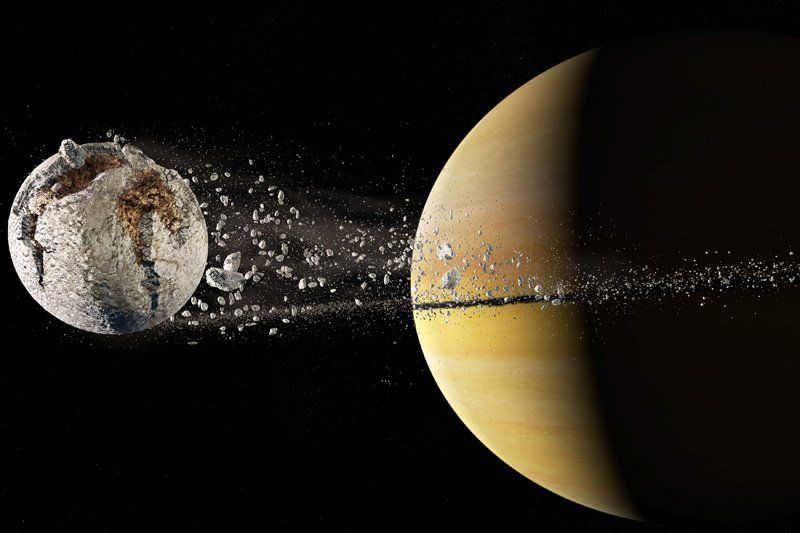

The rings of Saturn came into existence following the destruction of several large moons.
In 2006, it was discovered that the outer E ring was created by the moon Enceladus, which revolves in close proximity. Enceladus exhibits a phenomenon known as ice geysers, where water is expelled from its interior through cracks in its surface. These geysers can reach heights of up to 500 km, ejecting 250 kg of water vapor per second. Ice particles are formed from this vapor and leave a trail along the moon’s orbit.
The original mass of Saturn’s rings was 1,000 times greater than their current mass. Over time, the planet has absorbed the majority of the material, which is continuously deposited into its atmosphere. Throughout billions of years, numerous asteroids and comets have passed by, taking a substantial amount of matter with them. Some of these celestial bodies, however, fell victim to Saturn, being captured and crushed into fine dust.
Interestingly, Saturn’s moon Titan appears to be one of the primary moons responsible for the creation of the rings. Titan is the only moon that remains intact, while all the others have disappeared, leaving behind their shattered icy shells that form the magnificent ring system we see today. Although the rings were much more awe-inspiring billions of years ago.
Saturn is currently acknowledged to possess seven rings, which vary in size. The rings are designated as follows, starting from the planet: D, C, B, A, F, G, and E. These formations are quite substantial and can be observed through a powerful telescope from Earth. However, the E ring is not visible from Earth due to its thinness and has only been detected by probes.
The C, B, and A rings are easily visible even through amateur telescopes, and they are arranged in that order from the center of the planet. Positioned between the B and A rings is the Cassini gap, which is a sizable gap that can also be clearly seen using amateur telescopes.

A distant region on the planet remains shrouded in mystery.
The true quantity of these formations remains unknown. The reality is that these seven prominent rings fracture into an astonishing amount of thinner rings, resembling the grooves on a vinyl record. The sheer number of these rings is immense, making it nearly impossible to accurately count them all. Furthermore, the width of the entire disk spans millions of kilometers, and not all sections are visible in the optical spectrum.
Thus, we can only identify seven distinct rings, which stand out due to their unique colors or the gaps between them. The number of narrower rings within each larger ring remains a mystery. Additionally, as one approaches, the rings further divide into even narrower bands. Some of these bands are as slim as 10 meters, while others measure up to 1 km in width.
Identification of Saturn’s rings
As you may have observed, the rings have been designated with the letters of the Latin alphabet, commencing with the letter A. They are not arranged in a sequential manner. The most notable and largest rings are denoted as A, B, and C when viewed from an outer vantage point towards the planet. These rings were the initial ones to be detected.
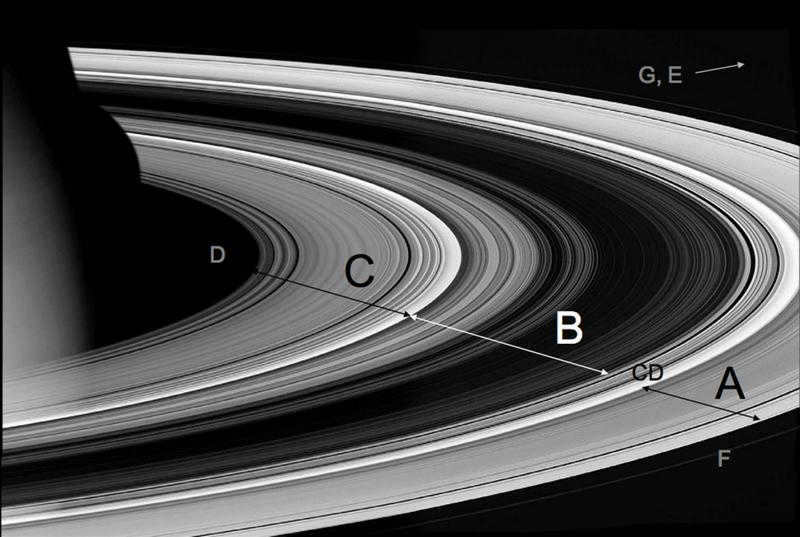
The configuration of the rings around Saturn.
Additional rings were subsequently detected, positioned both nearer to the planet than C and further away than A. Consequently, the rings designated with alternative letters occupy distinct positions. As a result, D is positioned closer to the planet, while F is situated on the outer edge.
The dimensions, composition, and weight of Saturn’s rings
As previously mentioned, the dimensions of these formations are a relative concept. Not all of them can be seen visually. For instance, the Phebe ring, which was identified in 2009, stretches to a distance of 13 million kilometers from the planet’s center. Naturally, it is quite sparse. It is possible that small particles can be detected at even greater distances.
The rings consist mostly of dust and water ice. The particle sizes range mostly from micrometers to a few centimeters. Of course, there are also some larger clusters, measuring several meters or even tens of meters in size, but they make up a small fraction of the overall mass.
During the Cassini mission, an interesting discovery was made – organic material – frozen ammonia, methane, and various other compounds – was found in the innermost D ring.
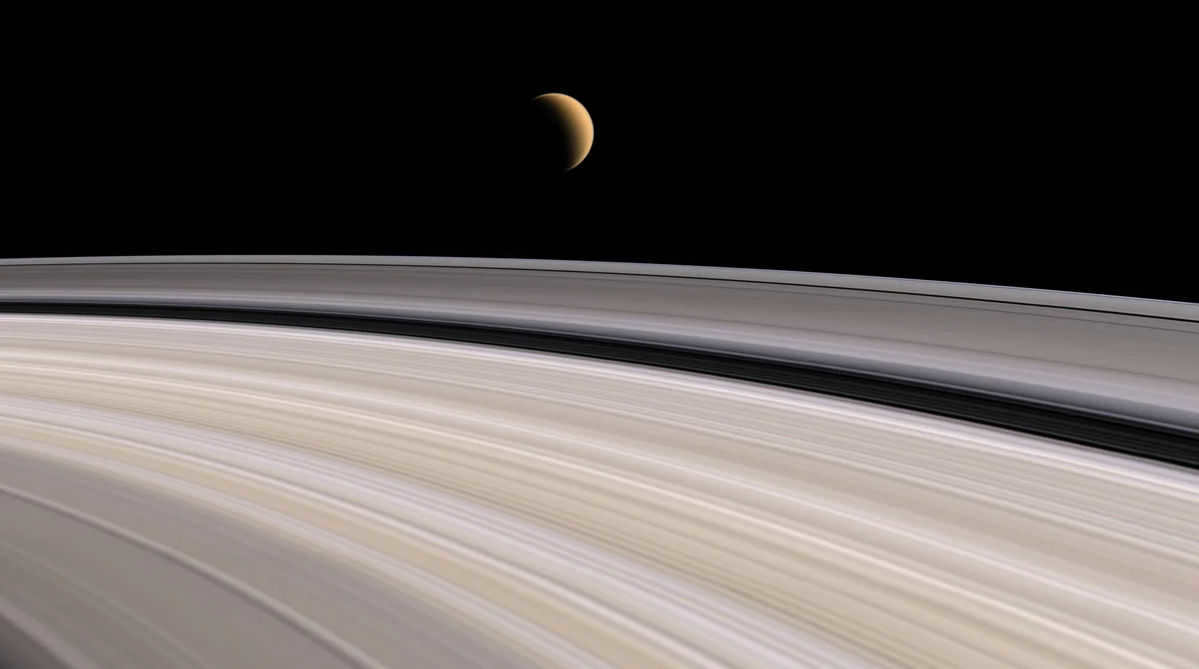
The photograph of the Cassini probe reveals the magnificent rings of Saturn and its satellite Titan.
Despite their impressive appearance, the rings currently lack substantial matter. If one were to gather all the material, it would only amount to a heap the size of Mimas, which has a diameter of approximately 400 kilometers. Over billions of years, the planet has been absorbing surrounding matter, causing it to gradually diminish in size.
Fascinatingly, the rings rotate around Saturn at varying speeds, with the outer rings moving slower than the inner ones. Rather than resembling the rotation of a solid gramophone record, their movement is more akin to that of water. This can be attributed to the fact that the rings consist of countless individual particles.
Based on information gathered by the Cassini spacecraft, the depletion of material from the rings is most prominent in regions near the planet. Saturn absorbs approximately 40 tons of matter per second from these areas. Over the course of several million years, Saturn’s rings will come to resemble those of Jupiter – extremely thin and virtually imperceptible.
The rings encompass a number of moons that revolve around the central disk. The largest of these moons have utilized their gravitational force to create cleared pathways within the ring system.
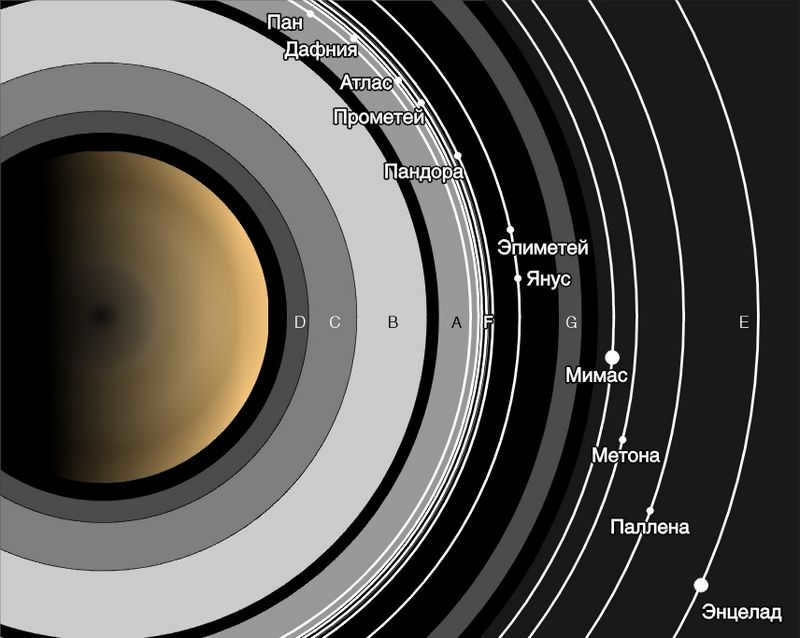

Some of the moons of Saturn are located within the rings.
Observing Saturn’s rings
The rings are situated in Saturn’s equatorial plane, while Saturn itself is tilted at an angle of approximately 27 degrees to the ecliptic. Consequently, we observe them from different angles of inclination at different times. On certain occasions, they are oriented edge-on to Earth and become virtually invisible due to their extremely thin nature. This is precisely what Galileo experienced in 1612 when he failed to detect them.
They vanish during Saturn’s equinox, after which they gradually start to open wider over a period of 7 years, followed by a 7-year decrease in angle until it reaches zero. Then the cycle repeats.
It is feasible to witness the Saturn’s rings even with a compact telescope equipped with a 60-70 mm lens. In case you possess exceptional visual acuity, they might even be discernible through binoculars, albeit without the level of detail such as tiny protrusions on the planet’s periphery.
Nevertheless, when viewed through a telescope, a significantly greater level of detail becomes apparent and the rings can be observed with clarity. With adequate exposure, it is possible to distinguish the Cassini gap without much effort. Implementing a blue filter can further enhance the visibility of additional intricate features.
